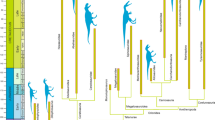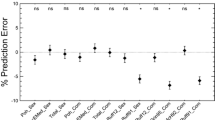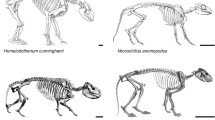Abstract
Both body mass and surface area are factors determining the essence of any living organism. This should also hold true for an extinct organism such as a dinosaur. The present report discusses the use of a new 3D laser scanner method to establish body masses and surface areas of an Asian elephant (Zoological Museum of Copenhagen, Denmark) and of Plateosaurus engelhardti, a prosauropod from the Upper Triassic, exhibited at the Paleontological Museum in Tübingen (Germany). This method was used to study the effect that slight changes in body shape had on body mass for P. engelhardti. It was established that body volumes varied between 0.79 m3 (slim version) and 1.14 m3 (robust version), resulting in a presumable body mass of 630 and 912 kg, respectively. The total body surface areas ranged between 8.8 and 10.2 m2, of which, in both reconstructions of P. engelhardti, ∼33% account for the thorax area alone. The main difference between the two models is in the tail and hind limb reconstruction. The tail of the slim version has a surface area of 1.98 m2, whereas that of the robust version has a surface area of 2.73 m2. The body volumes calculated for the slim version were as follows: head 0.006 m3, neck 0.016 m3, fore limbs 0.020 m3, hind limbs 0.08 m3, thoracic cavity 0.533 m3, and tail 0.136 m3. For the robust model, the following volumes were established: 0.01 m3 head, neck 0.026 m3, fore limbs 0.025 m3, hind limbs 0.18 m3, thoracic cavity 0.616 m3, and finally, tail 0.28 m3. Based on these body volumes, scaling equations were used to assess the size that the organs of this extinct dinosaur have.




Similar content being viewed by others
References
Alexander RM (1989) Dynamics of dinosaurs and other extinct giants. Columbia University Press, New York
Anderson JF, Rahn H, Prange HD (1979) Scaling of supportive tissue mass. Q Rev Biol 54:139–148
Anderson JF, Hall-Martin A, Russell DA (1985) Long-bone circumference and weight in mammals, birds, and dinosaurs. J Zool (London) 207:53–61
Bellmann A, Suthau T, Stoinski S, Friedrich A, Hellwich O, Gunga H-C (2005) 3D-modelling of dinosaurs. In: Grün/Kahmen (ed) Optical 3-D measurement techniques VII (Proceedings of the 7th Conference) Part 1, Vienna
Blob RW (1998) Evaluation of vent position from lizard skeletons for estimation snout-vent length and body mass. Copeia 3:792–801
Calder EH (1984) Size, function, and life history. Harvard University Press, Cambridge, Massachusetts
Calder EH (1996) Size, function, and life history. Harvard University Press, Cambridge, Massachusetts
Christiansen P, Fariña RA (2004) Mass prediction in theropod dinosaurs. Historical Biology: Journal of Paleobiology 16:85–92
Clauss M, Robert N, Walzer, Vitaud C, Hummel J (2005) Testing predictions on body mass and gut contents: dissection of an African elephant Loxodonta africana Blumenbach 1797. Eur J Wildl Res 51:291–294
Colbert EH (1962) The weights of dinosaurs. Am Mus Novit 2076:1–16
Galton PM, Upchurch P (2004) Prosauropoda. In: Weishampel DB, Dodson P, Osmolska H (eds) The Dinosauria (2nd edn). University of California Press, Berkeley, pp 232–258
Gunga H-C, Kirsch K, Baartz F, Röcker L, Heinrich W-D, Lisowski W, Wiedemann A, Albertz J (1995) New data on the dimensions of Brachiosaurus brancai and their physiological implications. Naturwissenschaften 82:190–192
Gunga H-C, Kirsch K, Rittweger J, Clarke A, Albertz J, Wiedemann A, Mokry S, Suthau T, Wehr A, Clarke D, Heinrich W-D, Schultze H-P (1999) Body size and body volume distribution in two sauropods from the Upper Jurassic of Tendaguru/Tansania (East Africa). Mitteilungen aus dem Museum für Naturkunde in Berlin. Geowissenschaftliche Reihe 2:91–102
Haubold H (1990) Die Dinosaurier. A. Ziemsen Verlag, Wittenberg
Henderson DM (1999) Estimating the masses and centers of masses of extinct animals by 3-D mathematical slicing. Paleobiology 25:88–106
Jung C (2002) Kernspintomographische Untersuchung der Relation zwischen Muskelvolumen, Muskelgeometrie und Knochengeometrie am Unterschenkel. FU Dissertation, Berlin
Klein (2004) Bone histology and growth of the prosauropod dinosaur Plateosaurus engelhardti MEYER, 1837 from the Norian bonebeds of Trossingen (Germany) and Frick (Switzerland). Dissertation, Bonn
Lambert D (1980) A field guide to dinosaurs. Avon, New York
Mallison H (2007) Virtual Dinosaurs - Developing Computer Aided Design and Computer Aided Engineering Modeling Methods for Vertebrate Paleontology. Doctoral Thesis, Eberhardt-Karls-Universität Tübingen
Moen DS (2006) Cope’s rule in cryptodiran turtles: do the body sizes of extant species reflect a trend of phyletic size increase? J Evol Biol 19:1210–1221
Motani R (2001) Estimating body mass from silhouettes: testing the assumption of elliptical body cross-sections. Paleobiology 27:735–750
Owen-Smith RN (1988) Megaherbivores. The influence of very large body size on ecology. Cambridge University Press, Cambridge
Peczkis J (1994) Implications of body-mass estimates for dinosaurs. J Vertebr Paleontol 14:520–533
Perry SF (1989) Mainstreams in the evolution of vertebrate respiratory structures. In: King AS, McLelland J (eds) Form and function in birds, vol 4. Chapter 1. Academic, London, pp l–67
Perry SF (1992) Gas exchange strategies in reptiles and the origin of the avian lung. In: Wood SC, Weber RE, Hargens AR, Millard RW (eds) Physiological adaptations in vertebrates. Respiration, circulation, and metabolism. Marcel Dekker, New York, pp 149–167
Sander PM (1999) Life history of the Tendaguru sauropods as deduced from long bone histology. Mitteilungen aus dem Museum für Naturkunde Berlin, Geowissenschaftliche Reihe 2:103–112
Sander PM (2000) Long bone histology of the Tendaguru sauropods: implication for growth and biology. Paleobiology 26:466–488
Sander PM, Klein N (2005) Developmental plasticity in the life history of a prosauropod dinosaur. Science 310:1800–1802
Schmidt-Nielsen K (1997) Animal physiology. Cambridge University Press, Cambridge
Schmidt-Nielsen K (1984) Scaling: why is animal size so important? Cambridge University Press, Cambridge
Seebacher F (2001) A new method to calculate allometric length-mass relationships of dinosaurs. J Vertebr Paleontol 21:51–60
Wedel MJ (2003) Vertebral pneumaticity, air sacs, and the physiology of sauropod dinosaurs. Paleobiology 29:243–255
Wedel MJ (2005) Postcranial skeletal pneumaticity in sauropods and its implications for mass estimates. In: Wilson JA, Curry-Rogers K (eds) The sauropods: evolution and paleobiology. University of California Press, pp 201–228
Weibel ER, Taylor CR (eds) (1981) Design of the mammalian respiratory system. Respir Physiol 44:1–164
Wiedemann A, Wehr A (1998) Vermessung von Dinosaurierskeletten mit Stereophotogrammetrie und Laserscanner. Publikationen der Deutschen Gesellschaft für Photogrammetrie und Fernerkundung 6:301–308
Wiedemann A, Suthau T, Albertz J (1999) Photogrammetric survey of dinosaur skeletons. Mitteilungen aus dem Museum für Naturkunde Berlin, Geowissenschaftliche Reihe Band 2:113–119
Withers PC (1992) Comparative animal physiology. Saunders College Publishing, Fort Worth
Acknowledgments
We wish to thank all the members of the DFG (Deutsche Forschungsgemeinschaft) Research Unit 533 “Biology of the sauropod dinosaurs: the evolution of gigantism”. Further thanks go to the staff of the institutions in which we measured the skeletons, the Paleontological Museum of Tübingen and the Zoological Museum of Copenhagen, in particular for their enthusiastic response to our project, their patience and their support, and H. Mallison (Tübingen) for his help to calculate the centers of gravity. The project has been granted financial support from the DFG-GU 414/3-1.
Author information
Authors and Affiliations
Corresponding author
Rights and permissions
About this article
Cite this article
Gunga, HC., Suthau, T., Bellmann, A. et al. Body mass estimations for Plateosaurus engelhardti using laser scanning and 3D reconstruction methods. Naturwissenschaften 94, 623–630 (2007). https://doi.org/10.1007/s00114-007-0234-2
Received:
Revised:
Accepted:
Published:
Issue Date:
DOI: https://doi.org/10.1007/s00114-007-0234-2




